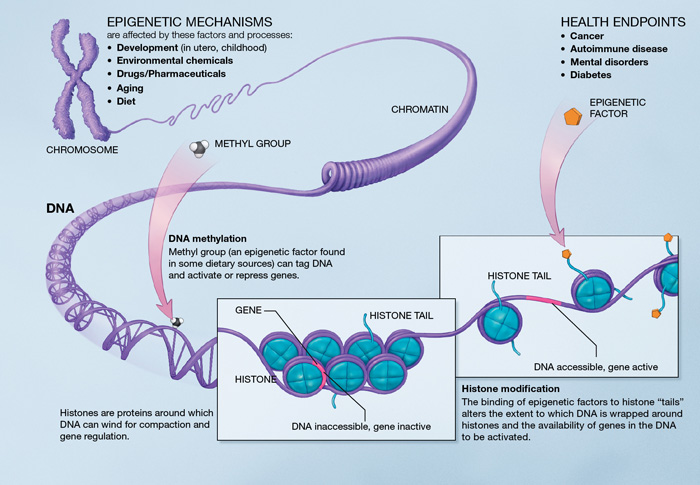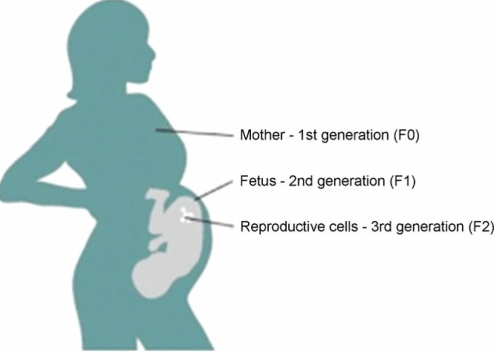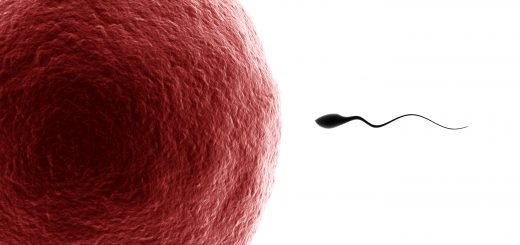Inheritance of your Ancestral Ghosts

Our ancestors leave behind more than just worldly possessions and interesting stories. They also provide us with our entire genetic material – the long-spanning DNA code made of the 4 bases we all know and love. However, recent advances in molecular biology hint that this genetic information may stretch further than simply a genetic code. How, you ask? Imagine your genetic information was also influenced by the meals your predecessors had, the world events they lived through, or their personal relationships. This branch of biology is called epigenetics and implies that various aspects of our parents’ or grandparents’ lifestyles affect the way you are today by triggering molecular changes to the way your DNA is packaged and modified in your body.
For example, it has been suggested recently that mothers exposed to the Dutch famine between 1944 and 1945, while pregnant, passed on such DNA modifications to their children, causing them to have an increased risk of mental disorders like schizophrenia, diabetes, obesity and heart disorders 1. In contrast, the children conceived after the famine did not exhibit these predispositions. It was proposed that the children conceived during the famine were “programmed” in the womb to store more energy and have a slower metabolism, which would have caused them to retain more nutritional resources when the supply of food was low. These effects have also been observed in the grandchildren of the famine-exposed females, hinting that the genetic influence of the mothers’ experiences was significant.
You’re probably wondering how the cells in your body could possibly know how much food there is to go around and how to best store energy according to the situation. This is where epigenetics comes into play. This branch of genetics deals with the epigenome, or the “covering” of your genome. It’s function is to instruct which, of around 20,000, genes should be expressed in a particular type of cell. You wouldn’t want your skin cells to start behaving like bone cells, would you? The epigenome consists of epigenetic “tags”, chemical groups that control when a gene is to be expressed by wrapping and unwrapping the DNA around proteins called histones (much like beads on a string) and adding chemical groups to the histones or the DNA itself, which activate or inactivate genes (figure 1).

Factors affecting epigenetic mechanisms and their consequences (https://en.wikipedia.org/wiki/Epigenetics)
These tags can alter every cell in the body, changing DNA based on a person’s lifestyle – this even includes the germ cells, which give rise to the sperm and eggs, that go on to form a brand new person. This means that the child will end up having the same epigenetically determined predisposition, be it susceptibility to weight gain or being able to handle stress efficiently. In the womb however, the baby developing from the aforementioned germ cells is slowly developing its own germ cells. In theory, epigenetic modifications induced by the mother’s behaviour would also be inherited by the baby’s germ cells that may one day contribute to the formation of a third generation. This may be one of the mechanisms through which our grandmother’s diet may have affected our development. (figure 2).

Image showing how three generations can all be influenced at once. (http://links.org.au/node/3861)
In the case of the children of the Dutch famine, researchers hypothesised that the affected children may be predisposed to obesity due to a smaller degree of methylation (adding a methyl group to the DNA) of the insulin-like growth factor II (IGF2) gene, which plays an important part in human development. This lower methylation level eventually led to variations in the expression of the IGF2 gene, which may have altered their metabolic rate.
Further evidence of how behaviour can alter the epigenome has been found in various other studies. For example, researchers at Emory University in the US discovered that even phobias may be passed on through generations via these epigenetic tags. They were able to induce extreme fear for the scent of cherry blossom in a set of mice. Interestingly, this phobia was passed on not only to their children, but also to the grandchildren and great-grandchildren. The younger generations exhibited similar panic to the smell of cherry blossom, even though they had never been exposed to it before 2 . Similar results were replicated in a study performed by Mount Sinai Hospital in the US where 32 Jewish families who had been present during the Holocaust were analysed against Jews not involved in the war. They found that the children and grandchildren of the former group were more inclined to have stress disorders. The study showed there was a higher rate of methylation in the FKBP5 gene, suppressing its expression in the victims and subsequent generations of Holocaust survivors 3. This indicates that the Holocaust experience had altered the genes of their ancestors, which were inherited by their kids and so on.
This is just a glimpse of how the echoes of the past are inherited in future generations. Epigenetics is a vast topic, and controls many other aspects of our life and behavior, most of which we don’t think about. From falling in love, to suffering with depression, everything could potentially be controlled by our epigenome. What we do alters our epigenome and that alters the way our genes react. So before you starve yourself in the name of dieting, remember that this ghost will be inherited by the generations to come.
This article was specialist edited by Teodora Aldea & copy-edited by Nicole Nayar











The ratio of pedigree/purebred cats to random-bred cats variess from country to country.
There is no mention about cats in this article. Not sure how it relates to cats here though